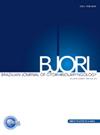Effects of inner ear abnormalities on middle ear mechanics: Findings from adults with MD and LVAS
IF 1.8
4区 医学
Q2 OTORHINOLARYNGOLOGY
引用次数: 0
Abstract
Objective
To evaluate the clinical significance of WAI as a predictive marker for MD and LVAS among adults.
Methods
Participants included 110 ears with MD, 18 ears with LVAS, and 92 normal ears (control group) recruited from clinical audiology settings. The outcome measures included Wideband Energy Absorbance (WBA), Resonance Frequency (RF), admittance Magnitude (YM), and phase Angle (YA). Propensity Score Matching (PSM) was conducted to treat the group imbalance.
Results
Compared with the control group, The MD group exhibited significantly lower WBA between 1587 and 4000 Hz (p < 0.05), while the LVAS group showed lower WBA between 1000 and 2520 Hz (p < 0.05). The MD and LVAS groups had lower RF (p < 0.05), while they had higher YM at low frequencies (226 and 678 Hz for MD, and 1000 Hz for LVAS, p < 0.05).
Conclusions
This study showed that LVAS has a lower WBA at middle frequencies, whereas MD has a lower WBA at middle and high frequencies. These findings suggest that WAI may serve as a predictive marker for MD and LVAS. However, further studies are needed to explore its diagnostic utility in Third Mobile Window Abnormalities (TMWA).
Level of evidence
IV: Retrospective cohort study.
内耳异常对中耳力学的影响:来自MD和LVAS成人的发现
目的探讨WAI作为成人MD和LVAS预测指标的临床意义。方法从临床听力学机构招募110只MD耳、18只LVAS耳和92只正常耳(对照组)。结果测量包括宽带能量吸光度(WBA)、共振频率(RF)、导纳幅度(YM)和相位角(YA)。采用倾向得分匹配(PSM)来处理群体失衡。结果与对照组相比,MD组在1587 ~ 4000 Hz范围内WBA显著降低(p < 0.05), LVAS组在1000 ~ 2520 Hz范围内WBA显著降低(p < 0.05)。MD组和LVAS组RF较低(p < 0.05),而低频YM较高(MD组为226和678 Hz, LVAS组为1000 Hz, p < 0.05)。结论LVAS中频WBA较低,而MD中高频WBA较低。这些发现提示WAI可作为MD和LVAS的预测标志物。然而,需要进一步的研究来探索其在第三移动窗异常(TMWA)中的诊断价值。证据水平iv:回顾性队列研究。
本文章由计算机程序翻译,如有差异,请以英文原文为准。
求助全文
约1分钟内获得全文
求助全文
来源期刊

Brazilian Journal of Otorhinolaryngology
OTORHINOLARYNGOLOGY-
CiteScore
3.00
自引率
0.00%
发文量
205
审稿时长
4-8 weeks
期刊介绍:
Brazilian Journal of Otorhinolaryngology publishes original contributions in otolaryngology and the associated areas (cranio-maxillo-facial surgery and phoniatrics). The aim of this journal is the national and international divulgation of the scientific production interesting to the otolaryngology, as well as the discussion, in editorials, of subjects of scientific, academic and professional relevance.
The Brazilian Journal of Otorhinolaryngology is born from the Revista Brasileira de Otorrinolaringologia, of which it is the English version, created and indexed by MEDLINE in 2005. It is the official scientific publication of the Brazilian Association of Otolaryngology and Cervicofacial Surgery. Its abbreviated title is Braz J Otorhinolaryngol., which should be used in bibliographies, footnotes and bibliographical references and strips.
 求助内容:
求助内容: 应助结果提醒方式:
应助结果提醒方式:


